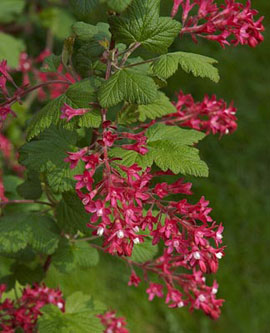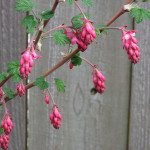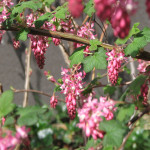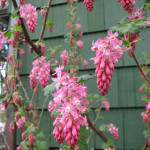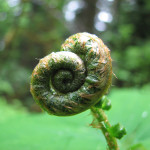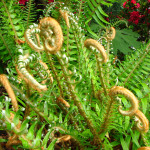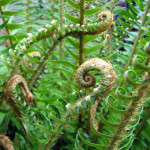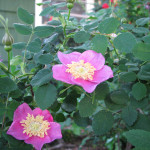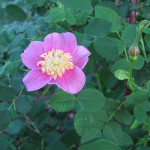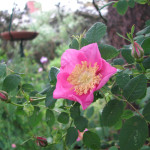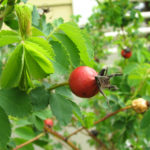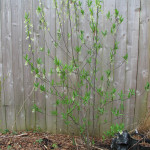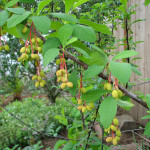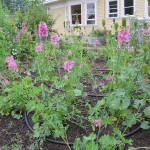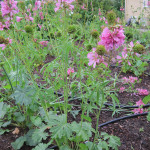Ribes sanguineum var. sanguineum
Red flowering currant (Ribes sanguineum) is an upright, multi-stemmed deciduous shrub that can get 6-10 feet tall, and is considered one of our prettiest native shrubs. Its bright pink, dangling flower clusters in late February and March are welcome signs of spring!
The bark is dark brownish-grey with pale brown lenticels. The palmate leaves have five lobes, and young leaves and flowers have a scent variously described as spicy or resinous. The fruits form as clusters of dark purple berries which contrast beautifully with the rosy gold fall foliage.
Keep a pair of binoculars handy if you plant this lovely shrub, because red flowering currant is a favorite of hummingbirds and other wildlife all year long. The flowers are important early spring nectar sources for rufous and Anna’s hummingbirds, spring azure and mourning cloak butterflies, and many native bees. Many birds eat the berries in the fall and winter, including towhees, thrushes, cedar waxwings, and sparrows. This charming plant also hosts the eggs of zephyr butterflies, and provides shelter for songbirds.
Red flowering currant can tolerate shade, but grows best (and blooms the most) in sunny locations with well drained soils.
- Light Requirements: Full Sun, Part Shade
- Water Requirements: Dry, Moist
- Ease of Growing: Easy to grow
- Growth Rate: Fast
- Spreads:
- Wildlife Support: Pollinators, Hummingbirds, Pest-eating Insects, Birds or Mammals
- Fire-resistant: Yes
- Edible: Yes
- Mature Height: 4-10ft
- Mature Width:3-10ft
Sword Fern
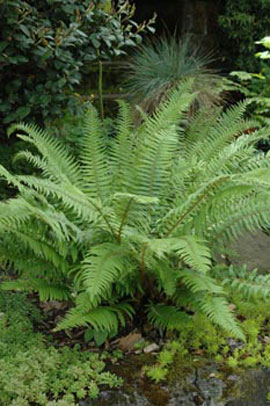
Polystichum munitum
Polystichum munitum (Western Sword Fern) is an evergreen fern native to western North America, where it is one of the most abundant ferns occurring along the Pacific coast from southeast Alaska south to southern California, and also inland east to southeastern British Columbia, northern Idaho and western Montana, with isolated populations in interior northern British Columbia, the Black Hills in South Dakota, and on Guadalupe Island off Baja California.
The dark green fronds of this fern grow to 50-180 cm tall, in a tight clump spreading out radially from a round base. They are single-pinnate, with the pinnae alternating on the stalk. Each pinna is 1-15 cm long, with a small upward-pointing lobe at the base, and the edges are serrated with bristly tips. Individual fronds live for 1.5-2.5 years and remain attached to the rhizome after withering. The round sori occupy two rows on either side of the midrib of each pinna and are covered by a centrally-attached, umbrella-like indusium with fringed edges. They produce light yellow spores.
The favored habitat of this fern is the understory of moist coniferous forests at low elevations. It grows best in a well-drained acidic soil of rich humus and small stones. Sword ferns are very tough, and can survive occasional dry periods once established.
While this fern is a favored horticultural subject in western North America, it has been found to be difficult or impossible to grow satisfactorily in the eastern part of the continent.
- Light Requirements: Part Shade, Full Shade
- Water Requirements: Dry, Moist
- Ease of Growing: Easy to grow
- Growth Rate: Moderate
- Spreads: No
- Wildlife Support: Birds or Mammals
- Fire-resistant: Yes
- Edible:
- Mature Height: 2-5ft
- Mature Width:2-4ft
Grand Fir

Abies grandis
Grand fir (Abies grandis) is a shade tolerant, slow-growing evergreen tree with short, dense branches. It can get quite tall in the wild, reaching 250 feet in height and with a trunk diameter of up to 6 feet.
The glossy dark green leaves are needle-like, 3-6 cm long, and extend flat out from the branch on either side. The 6-12 cm cones do not fall to the ground whole, but disintegrate on the tree and release their seeds about 6 months after pollination.
Grand fir is an important wildlife tree. The California tortoiseshell butterfly feeds on the sap and secretions from cones and needles. Grouse eat the needles, and nuthatches, chickadees, and squirrels eat the seeds. Grand firs also provide excellent cover and nesting habitat for birds and small mammals.
The foliage has an attractive tangerine-like scent, and Grand Firs are sometimes used for Christmas decoration, including as Christmas trees. It is also planted as an ornamental tree in large parks.
Grand fir needs well-drained soils and plenty of room to grow, and is an elegant addition to any landscape.
- Light Requirements: Full Sun, Part Shade, Full Shade
- Water Requirements: Moist, Seasonally Wet
- Ease of Growing: Easy to grow
- Growth Rate: Moderate
- Spreads: No
- Wildlife Support: Hummingbirds, Pest-eating Insects, Birds or Mammals
- Fire-resistant: No
- Edible: No
- Mature Height: 200ft
- Mature Width:40ft
Nootka Rose
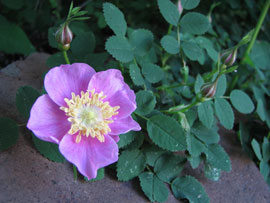
Rosa nutkana var. nutkana
The Nootka rose is an attractive shrub growing up to 9′ high. The straight, erect stems are usually green, but occasionally may be reddish. The prickles are larger and thicker than those of the other native rose species.
The leaves are alternate on the stems and pinnately compound with 5-7 leaflets, dark green above, paler and slightly hairy below. The leaflets are elliptic or ovate in shape with serrate margins, and range from 1-7 cm long and 0.7-4.5 cm wide.
The sweet-scented, pink flowers are usually solitary, occasionally growing in groups of 2 or 3. They are large and showy, ranging from 5-8 cm across. Individual petals are 2.5-4 cm long, and 5 petals are the norm for the flowers. The rose hips are spherical, orange-red and large, ranging from 1-2 cm wide.
Uses
Wild rose is spindly and tends to form loose thickets, which in large spaces makes it useful as a hedgerow or as a wildlife-friendly ornamental. The leaves and fruits are important food sources for herbivores and upland game birds, and rose thickets provide excellent nesting and escape habitat for songbirds. The plant also has many traditional uses in Native American culture. Rose hips can be made into jam, tea, and used as flavoring, and the leaves have a variety of medicinal uses. Dried flower petals are used for scents and potpourri.
Habitat
Nootka rose may be found in open upland woods or in open shrub wetlands. In areas where both Rosa nutkana and Rosa woodsii occur, the former may be found at higher elevations and often in woods.
- Light Requirements: Full Sun, Part Shade
- Water Requirements: Dry, Moist, Seasonally Wet
- Ease of Growing: Easy to grow
- Growth Rate: Moderate
- Spreads: Yes
- Wildlife Support: Pollinators, Pest-eating Insects, Birds or Mammals
- Fire-resistant: Yes
- Edible: Yes
- Mature Height: 6-10ft
- Mature Width:3-4ft
Osoberry
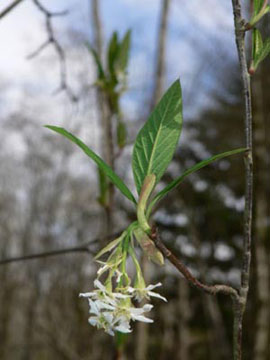
Oemleria cerasiformis
Osoberry is a fast-growing, multi-stemmed shrub to small tree with reddish to purplish-brown bark. In open sunny locations it may form a dense shrub, while in the shade it becomes more open to sprawling. This is one of our earliest flowering native shrubs, and its slender, lime-green leaves are one of the first signs that spring is on the way!
This woodland plant does best in moist areas with dappled shade, and can tolerate many soil types, including heavy clay.
In the early spring, both male and female osoberries produce dangling clumps of whitish flowers. Female plants will then produce small hard berries towards the end of summer (male plants produce no fruit). The fruit is peach-colored early in the season, maturing to blue-black in the fall, and is a favorite of many birds and small mammals. Osoberry also serves as a host for several caterpillar species, and the flowers are a source of nectar for butterflies, hummingbirds, and pollinators, making this an excellent wildlife plant.
- Light Requirements: Full Sun, Part Shade, Full Shade
- Water Requirements: Dry, Moist
- Ease of Growing: Easy to grow
- Growth Rate: Fast
- Spreads: No
- Wildlife Support: Birds or Mammals
- Fire-resistant: Yes
- Edible: Yes
- Mature Height: 15ft
- Mature Width:5-10ft
Cusick’s Checkermallow
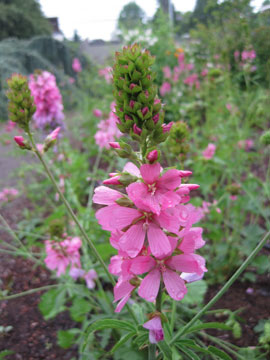
Sidalcea cusickii
A delightful, hollyhock-like perennial rarely found outside its native Oregon, and not in every county. Stands of this perennial have been reported in Washington, Multnomah, Yamhill, Benton, Linn, Lane, Douglas, Coos and Jackson counties, but not all are documented.
- Light Requirements: Full Sun, Part Shade
- Water Requirements: Dry, Moist
- Ease of Growing: Easy to grow
- Growth Rate: Fast
- Spreads:
- Wildlife Support: Pollinators, Birds or Mammals
- Fire-resistant: No
- Edible: Yes
- Mature Height: 4ft
- Mature Width:2ft
Lady Fern
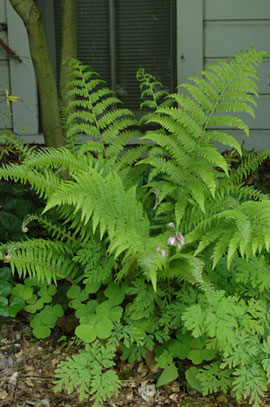
Athyrium filix-femina
Athyrium filix-femina (Lady Fern or Common Lady-fern) is a large, feathery species of fern native throughout most of the temperate Northern Hemisphere, where it is often abundant (one of the more common ferns) in damp, shady woodland environments and is often grown for decoration in shady home gardens.
- Light Requirements: Full Sun, Part Shade, Full Shade
- Water Requirements: Moist, Seasonally Wet
- Ease of Growing: Easy to grow
- Growth Rate: Moderate
- Spreads: No
- Wildlife Support: Hummingbirds, Birds or Mammals
- Fire-resistant: No
- Edible: No
- Mature Height: 4ft
- Mature Width:2ft
Wood Strawberry

Fragaria vesca ssp. bracteata
After flowering, rounded, egg-shaped, red edible berries appear in the late summer and early autumn. These appear to be smooth coated but are in fact covered in very short hairs, visible only at close range.
- Light Requirements: Full Sun, Part Shade
- Water Requirements: Dry, Moist
- Ease of Growing: Easy to grow
- Growth Rate: Moderate
- Spreads: Yes
- Wildlife Support: Birds or Mammals
- Fire-resistant: Yes
- Edible: Yes
- Mature Height: 6in
- Mature Width:1ft

